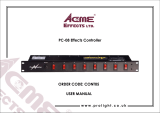
OM-889 Page 13
E. Connections To Sidebeam Carriage Control
WARNING: Read and follow safety informa-
tion at beginning of entire Section 4-3 before
proceeding.
1. If applicable, remove the four screws securing
the Carriage Control to the mounting bracket,
and remove the control from the bracket.
2. Remove the securing screws from control wrap-
per, and remove wrapper.
3. Loosen upper strain relief clamp on rear of con-
trol, and route remaining end of four-conductor
cord through clamp to terminal strip 1T.
4. Remove jumper links between terminals L and M
on terminal strip 1T.
5. Connect lead spliced to lead in five-conductor
cord (Section D, Step 9) to terminal D on 1T.
6. Connect lead installed to terminal V of receptacle
RC10 in Automatic Weld Control to terminal J on
1T.
7. Connect lead installed to terminal F of receptacle
RC4 in weld control to terminal L on 1T.
8. Connect lead installed to terminal H of receptacle
RC4 in the weld control to terminal J on 1T.
9. Tighten strain relief clamp, and reinstall and se-
cure control wrapper.
10. Reposition and secure control onto mounting
bracket.
4-4. REMOTE START/STOP CONNECTIONS FOR
NON-MILLER AUTOMATIC WELD CON-
TROLS (For Non-MILLER Controls Only)
WARNING: ELECTRIC SHOCK can kill.
• Do not touch live electrical parts.
• Shut down Carriage Control, Automatic Wel
Control, and welding power source, and dis-
connect input power employing lockout/tag-
ging procedures before making internal con-
nections.
Lockout/tagging procedures consist of remov-
ing input plug from receptacle, padlocking line
disconnect switch in open position, removing
fuses from fuse box, or shutting off and red-tag-
ging circuit breaker or other disconnecting de-
vice.
WORN OR CUT CORD can cause serious
personal injury or equipment damage.
• Route and secure all cords from welding pow-
er source to Carriage Control and Automatic
Weld Control over top of beam between car-
riage release lever and carriage motor cas-
ing.
• Secure cords away from motor pinion gea
and beam gear rack on back of beam.
• Secure all cords away from work area.
A. Carriage Control Relay Contact Selection
WARNING: Read and follow safety informa-
tion at beginning of entire Section 4-4 before
proceeding.
The Carriage Control is equipped with a normally-open
and normally-closed relay contact which enables re-
mote start and stop control of an Automatic Weld Con-
trol. The normally-open relay contact is between termi-
nals A and B on terminal strip 2T, and the normally-
closed relay contact is between terminals B and C on 2T.
Both contacts energize whenever the START button is
activated or the weld control is remotely activated. Both
relay contacts deenergize when the STOP button is ac-
tivated (remote or front panel switch).
Determine which connection the Automatic Weld Con-
trol requires (normally-open or normally-closed), and
proceed to Section 4-4B.
B. Interconnecting Cord Selection
To determine if one of the supplied cords may be suit-
able for use with an Automatic Weld Control, compare
the supplied cord connectors to the weld control con-
nectors.
If the supplied cords are not suitable for the weld control,
either wire a plug or cord to interface with the weld con-
trol, or obtain interconnecting cords of proper type and
length to make connections from Carriage Control to
Automatic Weld Control. (Cords should be two-wire, No.
18, and as long as required for installation.)
IMPORTANT: After selecting or obtaining cord suitable
for weld control, discard remaining supplied cords, and
proceed to Section 4-4C.
C. Connections For Remote Start/Stop Control
WARNING: Read and follow safety informa-
tion at beginning of entire Section 4-4 before
proceeding.
To connect Carriage Control to provide remote start and
stop control of an Automatic Weld Control, proceed as
follows:
1. Remove four screws securing Carriage Control
to the mounting bracket, and remove control from
bracket.
2. Remove securing screws from control wrapper,
and remove wrapper.
3. Loosen strain relief on clamp or rear of control,
and route cord through clamp to terminal strip 2T.
4. If Automatic Weld Control requires installation to
the normally-open relay contact, install leads
from cord R to terminals A and B on terminal strip
2T.
5. If Automatic Weld Control requires installation to
the normally-closed relay contact, install leads
from cord R to terminals B and C on terminal strip
2T.
6. Reinstall and secure control wrapper.
7. Reposition and secure control onto mounting
bracket.





















